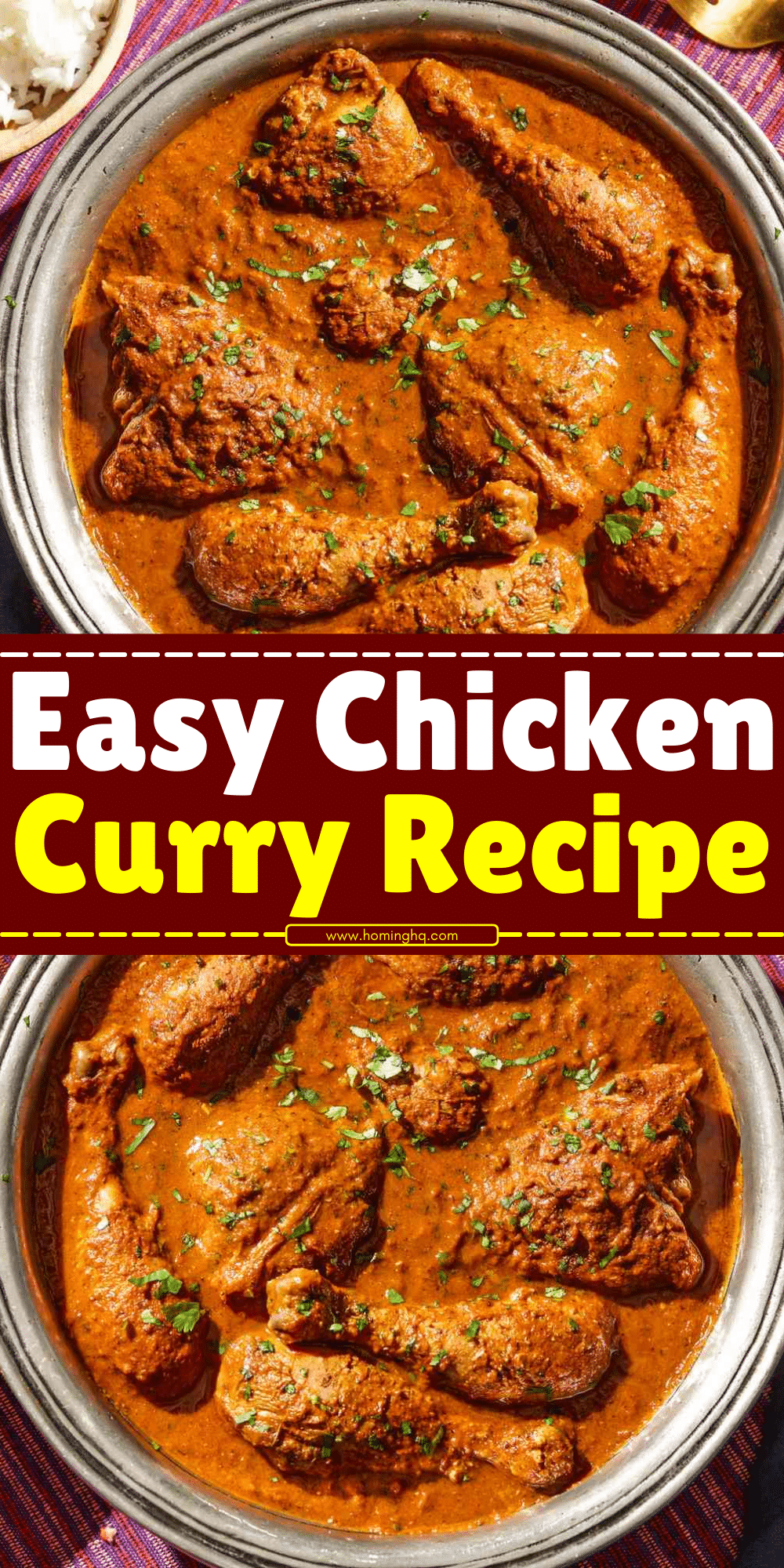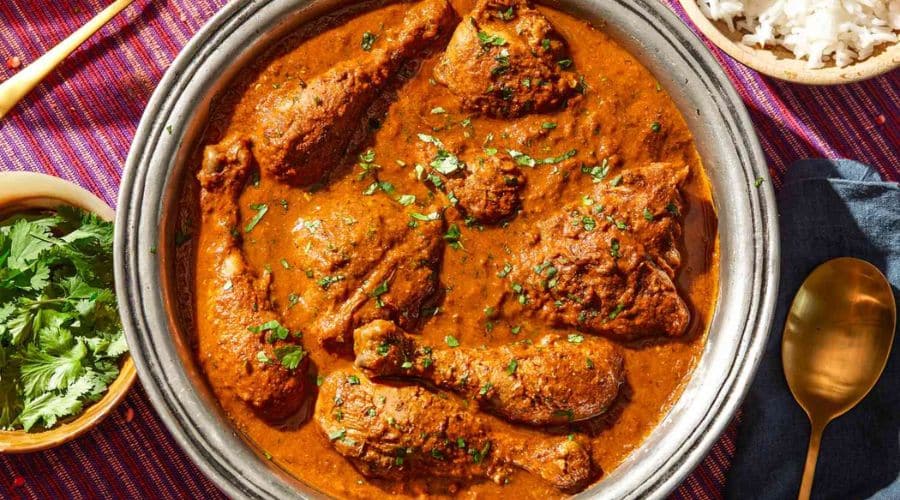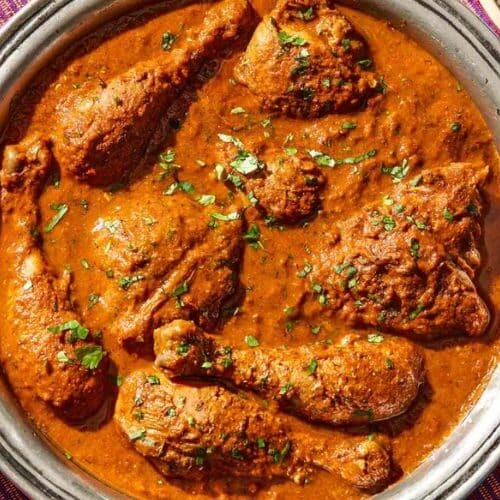All products are selected by our editorial team for quality. If you buy through our links, we may earn a small commission at no extra cost to you.
Chicken curry is a globally adored dish, known for its rich flavors and aromatic spices.
It’s more than just a meal; it’s an experience of warmth and comfort, enjoyed by many across different cultures.
Whether it’s the classic Indian version, a Thai coconut curry, or the spicier Caribbean take, chicken curry has become synonymous with home-cooked goodness.
Originating from South Asia, chicken curry has evolved through centuries, making its way into kitchens worldwide.
It’s a dish that showcases the beauty of balancing spices, heat, and creaminess, making it endlessly customizable to suit your tastes.
You can have it mild or fiery, with a deep, complex flavor profile or a simple, soothing one—this versatility is what makes chicken curry a favorite in many households.

What You Need to Make Chicken Curry
To make a flavorful chicken curry, you need a few core ingredients.
These are typically found in your local grocery store and form the base for creating the rich, aromatic sauce.
The main ingredients include fresh chicken (either boneless or bone-in, depending on your preference), onions, garlic, ginger, tomatoes, and a blend of essential spices.
Some of the most common spices used are cumin, coriander, turmeric, and garam masala, which give the curry its distinct aroma and taste.
Coconut milk or yogurt is often added for creaminess, and fresh cilantro is used for garnish.
Optional Ingredients for Variation
Chicken curry is highly customizable. You can incorporate vegetables like potatoes, carrots, peas, or spinach to add texture and nutrition.
For a different twist, you could also swap chicken for lamb, beef, or even tofu to suit dietary preferences or create a variety of flavors.
Preparing the Chicken and Ingredients
When preparing chicken curry, selecting the right chicken is essential to achieve the best texture and flavor.
Fresh, high-quality chicken will give the curry a tender, juicy bite.
You can choose between boneless chicken breast or thigh pieces for a leaner, quicker option, or bone-in chicken for richer flavor.
Bone-in chicken tends to enhance the curry’s flavor as it simmers in the sauce, making it ideal for longer cooking times.
Prepping Vegetables and Spices
For a smooth curry experience, proper prep is key. Start by chopping onions finely and grating or mincing garlic and ginger.
The freshness of these ingredients helps form the curry’s base flavor. Tomatoes can be diced or pureed to create a smooth sauce.
Spices should be measured carefully. For a more intense flavor, you can toast whole spices like cumin seeds or coriander seeds before grinding them into a powder.
This helps release their natural oils and enhances the aroma.
Don’t forget to prepare your liquid base—coconut milk or stock, depending on your recipe—ready to add once the chicken is browned and the spices have been sautéed.
Making the Chicken Curry

Step-by-Step Guide to Cooking Chicken Curry
Once all the ingredients are prepped, the next step is to bring everything together into a delicious curry.
Start by heating oil in a large pot or Dutch oven over medium heat.
Add finely chopped onions and sauté until golden brown, which helps to develop a deep, savory base.
Then, add ginger and garlic and cook until fragrant.
Next, stir in the ground spices (such as curry powder, turmeric, cumin, coriander) and let them cook for a minute or two to release their essential oils.
At this point, you can add the chicken pieces. Sauté them until they’re browned on all sides, which adds depth of flavor to the curry.
Once the chicken is browned, add the tomatoes, and let them cook down into a thick sauce.
Then, pour in the coconut milk or stock and bring the mixture to a gentle simmer.
Allow the curry to cook for 20-30 minutes, letting the flavors meld and the sauce thicken.
For a perfect consistency, stir occasionally. You may also add a splash of water or broth if you prefer a thinner curry.
Taste and adjust the seasoning if necessary, adding salt or spice to your liking.
Tips for Perfecting Your Chicken Curry
Cooking Techniques to Enhance Flavor
To achieve a perfectly balanced chicken curry, several techniques can elevate your dish.
Searing the chicken first helps lock in moisture and creates a flavorful crust that infuses the curry.
Don’t rush the process of sautéing the onions, garlic, and spices—this step is crucial in developing the complex layers of flavor.
Allowing the curry to simmer gently rather than cooking it at a high heat helps all the flavors meld together, creating a smooth and rich sauce.
If possible, let the curry rest for 10-15 minutes before serving; this allows the flavors to intensify and improve over time.
Common Mistakes to Avoid
While making chicken curry, it’s easy to make a few common mistakes. Overcooking the chicken can cause it to become dry and tough.
To avoid this, ensure you don’t cook the chicken for too long; simmering it in the sauce is enough to cook it through while keeping it tender.
Another mistake is adding too much salt early in the cooking process.
Since the curry simmers, the flavors concentrate, and adding salt too soon may make the dish overly salty.
Always taste and adjust seasoning towards the end of cooking.
Lastly, be cautious with the spices—using too much turmeric or curry powder can overpower the dish.
Start with smaller amounts and taste as you go to achieve the right balance.
You have not enough Humanizer words left. Upgrade your Surfer plan.
Storing and Reheating Chicken Curry
How to Properly Store Leftovers
Storing chicken curry properly ensures it retains its delicious flavor for future meals.
Once your curry has cooled to room temperature, transfer it into an airtight container.
Make sure the curry is fully cooled before storing to avoid condensation, which can affect the texture.
Stored in the refrigerator, chicken curry can last for up to 3-4 days.
If you plan to store it for a longer period, consider freezing the curry.
Pour the cooled curry into freezer-safe containers or heavy-duty freezer bags.
It’s best to freeze the curry in individual portions, so you can easily reheat just the amount you need.
Chicken curry can stay frozen for up to 3 months without compromising flavor.
Reheating Tips
Reheating chicken curry can be done either on the stovetop or in the microwave, but it’s important to reheat it slowly to preserve its flavor and texture.
For stovetop reheating, place the curry in a pot and heat it over low to medium heat, stirring occasionally.
If the curry appears too thick, add a splash of water or broth to achieve the desired consistency.
For microwave reheating, transfer the curry to a microwave-safe dish, cover it with a microwave-safe lid or wrap it with a paper towel to prevent splatters.
Heat in 1-minute intervals, stirring in between, until it’s fully heated through. If the curry has thickened too much during storage, add a little water or coconut milk to bring it back to life.
Variations of Chicken Curry Around the World
Indian Chicken Curry
Indian chicken curry is one of the most popular and diverse versions of the dish. The key elements include rich, aromatic spices like garam masala, turmeric, cumin, and coriander.
The sauce is typically tomato-based, with a variety of creaminess added through yogurt, cream, or coconut milk. Indian chicken curry can range from mild to fiery hot, depending on regional preferences.
In North India, the curry is often served with naan or rice, while in South India, a more tangy version with coconut and tamarind may be found.
Thai Chicken Curry
Thai chicken curry differs in flavor profile due to the use of fresh herbs and unique ingredients like lemongrass, kaffir lime leaves, and galangal.
Thai curries also use curry pastes (red, green, or yellow), which combine fresh chili, garlic, ginger, and spices, creating a fragrant, slightly sweet, and tangy curry.
Coconut milk is a staple in Thai chicken curries, providing a rich, creamy texture that balances the heat from the chili peppers.
Thai chicken curry is often served with jasmine rice, making it the perfect combination of rich and aromatic flavors.
Caribbean Chicken Curry
Caribbean chicken curry has a distinct flavor profile, heavily influenced by the bold spices and tropical ingredients found in the region.
The use of scotch bonnet peppers gives it a fiery kick, while allspice adds warmth and depth.
Coconut milk is also used to add creaminess, but it is balanced with vinegar or lime juice to provide a zesty undertone.
Caribbean chicken curry is typically served with rice and peas, or roti, and it’s known for its vibrant, bold flavors.
Other Regional Versions
Chicken curry has countless variations across the world, influenced by local ingredients and cooking methods.
In the Middle East, chicken curry might include dried fruits like apricots or raisins, and spices such as cinnamon, cardamom, and saffron, resulting in a more aromatic, slightly sweet curry.
In West Africa, ground peanuts or peanut butter might be added, creating a rich, nutty base.
Each region’s version offers unique twists that showcase the diversity and adaptability of chicken curry.
conclusion
Chicken curry is a dish that brings comfort, flavor, and versatility into one pot.
With a rich history that spans across continents, this dish can be tailored to fit any palate—whether you prefer it mild or with a serious kick.
The balance of spices, tender chicken, and creamy sauce creates a satisfying meal that can be enjoyed by everyone.
And, with the added bonus of being able to customize it with your favorite ingredients, chicken curry is a dish you’ll keep coming back to.
Whether you’re cooking for a weeknight dinner or a special gathering, this recipe is sure to impress.
Chicken curry is not a dish with rigid rules—feel free to experiment and make it your own!
Play with different spices, vegetables, and proteins to create a version that suits your tastes.
The beauty of curry lies in its flexibility, so don’t hesitate to get creative in the kitchen.
Frequently Asked Questions
1. Can I make chicken curry ahead of time?
Yes, chicken curry actually improves in flavor when allowed to sit for a few hours or even overnight.
The spices have more time to meld together, and the overall taste becomes richer.
Simply refrigerate it after cooking and reheat when you’re ready to serve.
2. Can I freeze chicken curry?
Absolutely! Chicken curry freezes well. After the curry has cooled to room temperature, store it in an airtight container or a freezer-safe bag.
It will stay fresh for up to 3 months. When reheating, you may need to add a little water or coconut milk to adjust the consistency.
3. How do I make my chicken curry less greasy?
If your curry turns out too greasy, there are a couple of solutions. First, try skimming off any excess oil from the surface while it simmers.
You can also use less oil at the beginning of the cooking process or opt for a leaner cut of chicken, like boneless chicken breast.
4. Can I make a vegetarian version of chicken curry?
Yes, you can easily make a vegetarian version of chicken curry by swapping the chicken with plant-based proteins like tofu, tempeh, or even chickpeas.
You can also add extra vegetables like potatoes, carrots, or spinach for a hearty dish.
5. How do I make my chicken curry spicier?
To increase the heat in your chicken curry, you can add fresh chili peppers, chili powder, or cayenne pepper to the sauce.
You can also use spicier curry pastes (like Thai red curry paste) or add a dash of hot sauce.
Just be sure to taste as you go to avoid making it too spicy!

Chicken Curry
Equipment
- Large Pot or Dutch Oven – 1 (for cooking the curry)
- Chopping Knife – 1 (for cutting vegetables and chicken)
- Cutting Board: 1 (for chopping ingredients)
- Measuring Spoons – 1 set (for measuring spices)
- Measuring Cups – 1 set (for liquids)
- Stirring Spoon – 1 (wooden or silicone)
Ingredients
- 2 lbs 900g Chicken (boneless or bone-in, cut into chunks)
- 2 tbsp Vegetable Oil
- 1 large Onion chopped
- 4 cloves Garlic minced
- 1- inch piece Ginger grated or minced
- 1 can 14 oz Coconut Milk
- 2 medium Tomatoes chopped or pureed
- 2 tbsp Curry Powder
- 1 tbsp Ground Cumin
- 1 tbsp Ground Coriander
- 1 tsp Ground Turmeric
- 1 tsp Garam Masala
- 1 tsp Salt to taste
- 1/2 tsp Ground Black Pepper
- 1 cup Chicken Stock or Water
- Fresh Cilantro for garnish
- Lime Wedges optional, for serving
Instructions
Heat Oil
- In a large pot or Dutch oven, heat the vegetable oil over medium heat. Add the chopped onion and sauté until soft and golden, about 5-7 minutes.
Add Garlic and Ginger
- Add the minced garlic and ginger to the pot and cook for another 1-2 minutes until fragrant.
Cook the Spices
- Stir in the curry powder, cumin, coriander, turmeric, and garam masala. Cook the spices for 1-2 minutes to release their flavors, stirring constantly to avoid burning.
Brown the Chicken
- Add the chicken pieces to the pot and stir to coat them in the spices. Sauté until the chicken is lightly browned on all sides, about 5-7 minutes.
Add Tomatoes and Coconut Milk
- Add the chopped tomatoes and cook for 3-4 minutes until softened. Then pour in the coconut milk and chicken stock (or water), and stir everything together.
Simmer
- Bring the curry to a simmer, then reduce the heat and cover the pot. Let the curry cook for 20-30 minutes, or until the chicken is cooked through and tender.
Adjust Seasoning
- Taste the curry and add salt or pepper if needed. If you prefer a thicker curry, let it simmer uncovered for a few more minutes.
Serve
- Garnish with fresh cilantro and serve with rice, naan, or your favorite side dish. Add a squeeze of lime for extra freshness if desired.
Notes
- Spice Level: Adjust the amount of curry powder and spices to your liking. If you prefer a milder curry, reduce the amount of turmeric or curry powder.
- Creaminess: For a richer sauce, use full-fat coconut milk. You can substitute with low-fat coconut milk for a lighter version.
- Vegetable Add-ins: Feel free to add vegetables like potatoes, carrots, or peas for extra texture and flavor.
- Serving Suggestions: This chicken curry pairs perfectly with white rice, basmati rice, or warm naan. A side of raita or a simple salad adds a refreshing contrast.
- Storage: Leftovers can be stored in an airtight container in the fridge for 3-4 days. You can also freeze it for up to 3 months.

